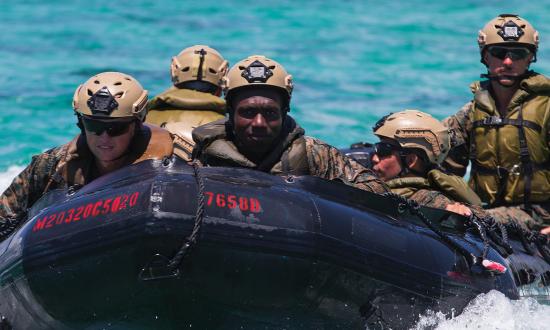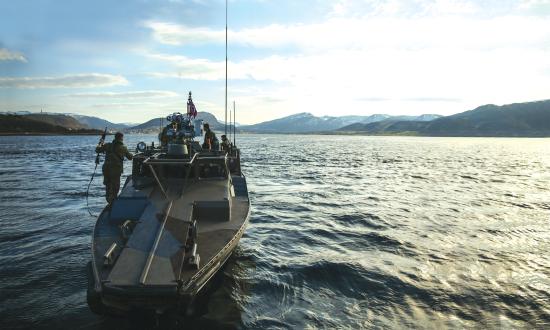There is much discussion about the correct number of amphibious ships for the Navy and their role in 21st-century warfare. Regardless of whether the world will ever see another amphibious operation on the scale of Iwo Jima or Normandy, ruling out opposed landings as justification for programmatic and force-structure decisions risks the loss of operational flexibility and courts defeat for the joint force in a high-end fight against a peer adversary.
Opposed Landings
Although the Navy and Marine Corps do not intend to conduct opposed landings in a future conflict, the enemy still gets a vote, and operational or tactical circumstances may dictate otherwise. However, both the landing craft, air cushioned (LCAC) and landing craft, utility (LCU) are “thinned skinned,” lacking protection against anything larger than small-arms fire. In the case of the LCAC, even small-arms fire exposes the craft to mission ineffectiveness because of its rubber lift skirt and exposed propulsion propellers. Once a permissive environment is established in the amphibious objective area, LCAC and LCU connectors can be used to build combat power ashore. The Marine Corps’ AAVP-7A1 (formerly known as landing vehicle, tracked, personnel-7, or LVTP-7), a fully tracked, “swimmable” amphibious landing vehicle is being phased out because of age and material concerns. Its replacement—the amphibious combat vehicle (ACV), a wheeled, armored combat vehicle that will provide improved ground-combat capability—has not, as of this writing, been certified for open water ship-to-shore movement. The extent of the ACV’s ability to swim, and at what range, remains to be determined.
That leaves an air-only assault option for an opposed landing. An insertion of the landing force exclusively by air elements—CH-53 helicopters and MV-22 Osprey tilt-rotor aircraft—may be the right answer for certain scenarios, but these aircraft are just as vulnerable to enemy fire as the landing craft. Leaving the amphibious task force commanders only one option in their toolkit of options is not a recipe for success. As 20th-century British military author and historian B. H. Liddell Hart noted, “The ability to strike at land from unexpected and/or advantageous direction gives a flexibility which is the greatest strategic asset that a maritime nation can possess.”1 What to do, then?
Enter the CB-90
The Navy and Marine Corps should consider procuring and employing the Swedish Combat Boat 90 (CB-90) or similar craft for amphibious operations as an integral component of the Navy–Marine Corps amphibious team. The CB-90 is a fast military assault craft developed by Swedish boat maker Dockstavarvet, part of Saab industries. The CB-90 has been around since 1991 and is operated by naval forces worldwide. In fact, U.S. boat builder SAFE Boats International built the CB-90 for the U.S. Navy. With a top speed in excess of 40 knots, the CB-90 is also armed with a remote-control twin gun mount atop the wheelhouse. This mount can handle a .50-caliber machine gun and a 40-mm grenade launcher. In addition to its speed and firepower, the CB-90 has ballistic protection for its vital spaces.
At a little over 50-feet long with a 13-foot beam, between 12 and perhaps up to 15 CB-90s could be accommodated in the well deck of a Wasp-class amphibious assault ship (LHD). The Wasp class can accommodate three LCACs positioned lengthwise bow to stern in its well deck. Each LCAC is 90-feet long with a beam of 50 feet. Even with a smaller well deck, the San Antonio–class amphibious transport docks (LPDs) can accommodate up to nine CB-90s. Regarding weight considerations, the CB-90 at full combat load is 24 tons. Optimized for the delivery of heavy equipment and vehicles, each LCAC with a full load approaches 175 tons. A Wasp-class well deck full of 15 CB-90 craft, can carry about 300 tons versus a well deck of LCACs at 450 tons.
To be sure, it is not an apples-to-apples comparison. The CB-90 is designed to deliver 21 combat-loaded troops and 4.5 tons of cargo via its bow ramp system. The organic heavy machine guns and other crew-served and remote-control weapons of the CB-90 could provide limited supporting firepower for the embarked troops during the vulnerable approach to and landing on the beach. A landing that requires heavy equipment as well as troops would require a combination of CB-90 and LCAC waves, with LCACs landing once the beach is secured from hostile fire. Between 9 to 12 CB-90s could deliver a Marine Corps company landing team, with supporting hardware being brought in via LCAC.
Speed, Lethality, and Protection
The CB-90 can deliver the initial assault waves of the landing force to seize beachhead objectives necessary for LCACs and LCUs to bring in heavy equipment. With its armament and ballistic protection, the CB-90 can deliver its troops in the face of enemy fire with a degree of survivability for both the craft and embarked troops. In addition to its high speed, the CB-90’s combat radius is greater than 100 miles. An armed and armored, high-speed, long-range assault craft would finally realize the Marine Corps concept of operational maneuver from the sea (OMFTS). OMFTS combines the maneuver of Navy forces and the Marine air-ground task force to produce a seamless operation between actions at sea and on land. The goal is to use the operational maneuver space offered by the sea to turn the sea and littorals into vulnerable flanks for the enemy, to be attacked at the time and place of the naval commander’s choosing. OMFTS and its key enabling concept, ship-to-objective maneuver, have been around since the 1990s. However, OMFTS was never fully realized because of unsuitable landing craft and the cancellation of the expeditionary fighting vehicle, which was conceived to replace the AAV.
Hope is Not a Course of Action
Opposed amphibious operations cannot be wished away. For military planners to arbitrarily remove them as an option renders the utility of the Navy–Marine Corps amphibious team during a high-end fight against a peer or near-peer adversary problematic. Possessing the capability to conduct an opposed landing may be the best way to avoid having to conduct one. Adversaries relentlessly seek to exploit gaps and seams. If the Navy–Marine Corps team lacks a viable ability to conduct an opposed landing, it is a sure bet that a future adversary would seek to bring one about.
Opposed amphibious operations do not have to be on the scale of World War II landings to be effective. Even company landing team assaults and raids, launched at range from a squadron of CB-90s sortieing from an LHD or LPD positioned well over the horizon and supported by long-range precision fires could have dramatic effects on the enemy. Small-scale raids by company- and battalion-sized landing teams for the purpose of temporary seizure of islands and land features to destroy or neutralize military targets would fit nicely within the Marine Corps littoral operations in a contested environment (LOCE) concept.
The U.S. Navy acquired experience with the CB-90, operating them as riverine command boats until they were mostly replaced by the (now decommissioned) Mk VI patrol boats. In addition, a U.S. ship builder already has experience building the CB-90 under license. No modifications to the existing CB-90 design are necessary for it to be used in the amphibious assault role. The design even possesses a “kick stand” arrangement that allows it to safely ground itself in a ship’s well deck. Furthermore, the Navy seems bent on divesting itself of its riverine craft inventory despite the obvious utility of certain types, such as the CB-90 and MK-6 patrol boat in the littoral domain of a major maritime fight. Though it is preferable to “land where the enemy ain’t,” using CB-90s from disestablished riverine units to create at least two assault craft units seems like a good hedge if opposed landings become necessary in a future conflict.
1. B. H. Liddell Hart, Deterrent or Defense: A Fresh Look at the West’s Military Position (New York: Frederick A. Praeger, Inc., 1960).






